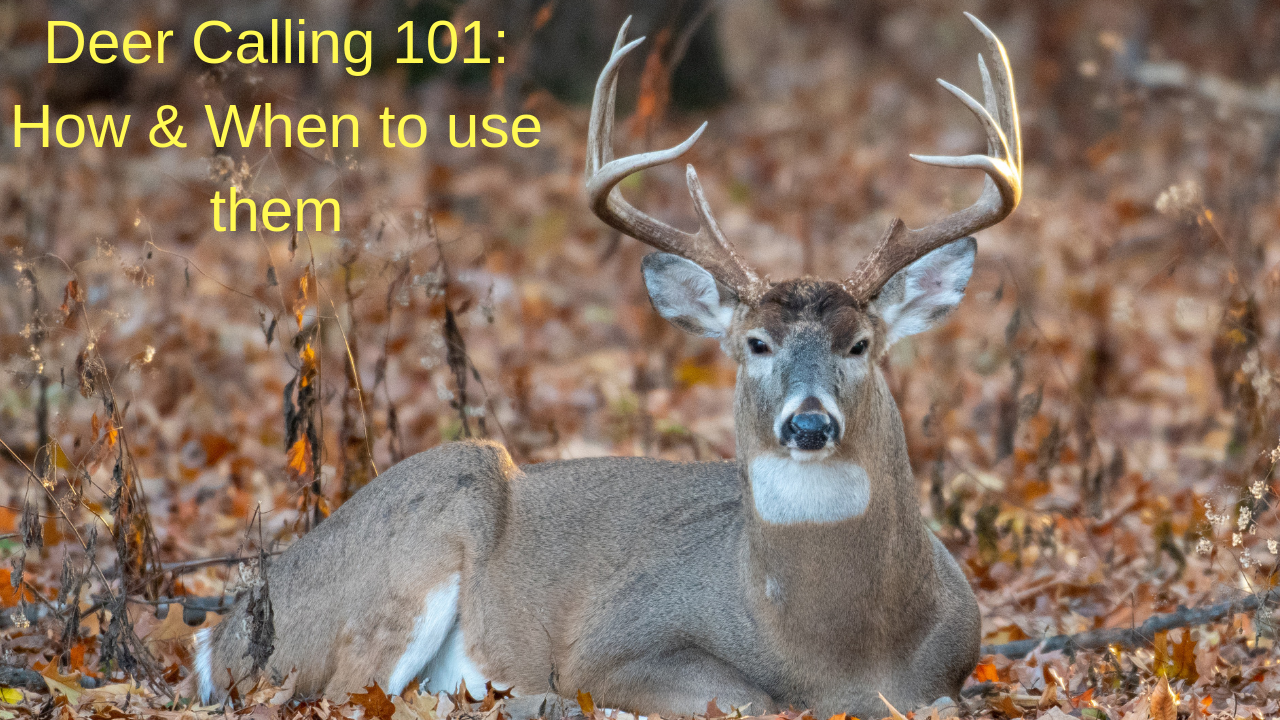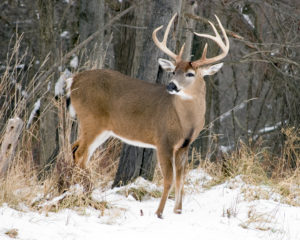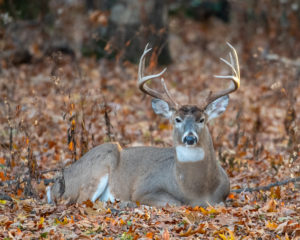Don’t let that buck of a lifetime walk by out of range. Use this deer calling 101 guide to bring him in.
Listen up Hunters.
This is the time whitetail hunters dream about all year. The breeding season is kicking off and their isn’t a better time to strategically use some whitetail deer calling than during these few weeks. Here is a Deer Calling 101 guide in deer vocalizations and how you can use them to take down a mature buck.
Most hunters are familiar with calls for deer, but some hunters have never used a deer call out of the fear of spooking Deer away. If you don’t know the sounds that the deer make and when to utilize a call is the problem. With this deer calling guide, you can be more confident in your ability to effectively communicate with the next time you are in the stand for deer hunting.
1.Why Use Deer Calls
Deer calls are a useful tool every deer hunter should be comfortable with. Each call is effective in different scenarios, either by themselves or combined with multiple calls to create a realistic picture for deer in you hunting area. That being said, hunting has no guarantees. Although, understanding how, when and why bucks and does communicate together with the right calls you can put yourself in a position to get a shot this season.
2. Deer calls
– Deer Calling can be Broken into four categories. There are the grunt, rattle, bleat and snort wheeze. Of all the sounds deer can make, almost all are a variation of one of these four sounds. Understanding the sounds and the calls for deer that match them, will take your deer hunting to the next level.
TYPES OF GRUNT CALLS
* Social grunts are calls bucks use to communicate to other deer in the herd. A social grunt can be used year-round, but usually is most effective during the rut. Does also produce a grunt, called the doe grunt, that is used around other does and fawns. A doe grunt is very similar to a social buck grunt except it is a higher tone and not as deep as a male whitetail.
* The trailing grunt. This grunt is from a buck that is actively on the trail of a hot doe. Trailing grunts are short bursts, consistent and even rhythmic. Deer calling with trailing grunts work best during the pre-rut as bucks are starting to enter rut mode searching for receptive doe.
*The tending grunt is a grunt variation that a buck uses when he has a doe acquired. This low, deep sound is great during the peak of the rut, when combined with a trailing grunt to mimic a buck that has chased and locked down a hot doe.
3. Doe Bleat
Deer calls such as the bleat mimics the vocalization of doe and fawns. Doe bleat throughout the year, but particularly during the rut when they’re sought out by bucks. Fawns will also make this sound to communicate with their mothers. Bleats from fawns are at a higher pitch than those from a mature doe.
Beats like the Extinguisher Grunt Call are effective when combined with grunt calls for deer. The combined sounds will intrigue mature bucks into thinking that a hot doe is being pursued by a rival buck looking to take one of his doe. Bleats by themselves can be used to communicate to other doe in the area. Other doe may bring in trailing bucks that otherwise wouldn’t have came into range on their own.
The easiest way to make a doe bleat is with a can call. Mouth blown callers can also be productive, but make sure you practice before you try them in the woods.
Bleats are most effective when combined with grunts because mature bucks will think another buck is taking his hot doe. Bleats can also call in doe looking for company and these doe may have the buck that you’ve been waiting for all season.
Types of Bleats
* The Estrus bleat is specifically used by doe that are ready to breed. An Estrous doe will use this call prior to making contact with a buck. A buck will take this sound as signal of a ready doe and come in to check her out.
Deer calls that mimic the estrous bleat of a doe are great during peak rut when many does are entering estrus and looking to breed. Blind calling with an estrus bleat will many times bring in a buck looking for a doe in estrus.
*Fawn call is the fawn in distress. Deer calling with a fawn in distress is an agitated sound often made by fawns who have been distanced from their mothers or are being chased by a predator.
The Fawn distress call is a good call for early season bow hunting when fawns are still with their mothers. Typically, doe will respond to this call no matter if they have fawns with them or not. Use this call to fill an early season doe tag or to possibly bring some pre-rut doe in with a searching buck on their trail.
4. Grunt Calls
All deer hunters are familiar with the grunt. It is one of the most popular calls for deer. The Bucks grunt during all phases of the rut including when making scrapes, rubbing trees, fighting and chasing doe. It is a communication to project dominance over a doe or other bucks in the area.
The soft grunt call is most effective when a buck is in sight but out of shooting range. You blow the call in quick bursts while the buck is turned away from you. If you grunt while a buck is facing you can easily give away your position. The grunt is a challenge of dominance and he will often start moving towards you if he is interested at all.
If the buck starts moving in your direction, get ready for a shot because he is likely to come in close. If he starts to leave, give him another grunt or two. This will sometimes irritate him enough to make him come in.
If the buck doesn’t respond after a two or three series of grunts, let him walk or try a different deer calling method. Overuse of any call will reduce its effectiveness in your hunting area.
In addition, grunt calls can be used for deer calling when a buck is not visible (cold calling). You can cold call by blowing two or three times every 30 minutes or so, varying from short to long grunts. A buck may not be in your area but by using deer calls like a grunt tube a buck may be inclined to checkout the sounds another buck is making in his territory.
5. Rattling
After grunt calls, rattling is the second most common call hunters know and use while deer hunting. Rattling is an aggressive deer calling tactic that simulates two bucks fighting during the rut.
Fighting often occurs throughout the rut cycle, from pre-rut to post-rut. The key is knowing how bucks spar with each other in the different phases of the rut. In the pre-rut, bucks are determining where they stand in dominance.
These are more likely soft altercations where bucks spar lightly. At the peak of the rut, bucks are aggressively challenging each other with more intense sparing/fighting for breeding rights to doe. Post-rut has little fighting between bucks, but rattling still comes in to play as those few remaining doe are finally coming into estrus and are contested for by Mature bucks.
Finding the perfect rattling tool
Rattling can be accomplished with real antlers, synthetic antlers, rattle bags or other innovative rattling systems. Nothing beats a real set of antlers when it comes to realistic sound but the black rack system by illusion systems comes close. If possible, hunters should use a set of antlers the same size as the bucks they are pursuing.
Rattling is not all about creating an all-out brawl in the woods. Keep your deer calling rattling strategy related to the phases of the rut. Too much rattling can be unnatural and can reduce your chances of bringing in dominate shooter bucks.
Try rattling with a few short and light rattles when a dominate buck is in the area. If he is in the right mood, he will react and come to show his dominance. During peak rut, crank up rattling to more aggressive fighting of two bucks.
Most of the time bucks will respond immediately if you do it right, but sometimes it can take time for a buck to move in to check out the call. Rattle for several sequences mixed with other deer calls like grunts, and then sit and wait for this calling strategy to pay off. Again, Bucks may respond immediately or up to 30 minutes after a rattling sequence. Keep your eyes peeled and watch this tried and true deer calling technique work for you
6. Snort Wheeze
If you have ever been lucky enough to hear a buck snort wheeze, then you know it is a call specifically for big bucks. The snort wheeze is a dominance call. Mature bucks use this sound to intimidate younger bucks.
The two short bursts of air followed by one longer one translate to “I am going beat you down.” It is made by a buck that is really fired up, and ready to fight!
Use the snort wheeze only when the time is right. Bucks, even mature, big tanks do not make this noise often. Hunters can use the snort wheeze to turn a dominate buck’s territorial instincts against him.
When deer calling using the snort wheeze you can either create an Angry, rut ready buck or send him the running the other way. The snort wheeze deer call won’t work all the time and it should not be your first choice among your deer calls, but it certainly has its place at the right time and with the right buck during the rut.
The snort wheeze is relatively easy to produce with your mouth and many grunt calls now come with a special snort wheeze attachment.

7. Bring It all Together
Save your deer calling for the pre-rut and rut when it will be most effective, and consider messing with a buck’s sense of smell by using scents in conjunction with calling. This will help sell the scenario that you are creating. By using a decoy also, you can make the picture come together and that can be the difference between a buck coming into range or not.
At the right time and place these deer calling techniques can be effective by themselves, but they will work best if you combine them to paint a picture for any buck within the area.
Start out with a doe bleat and a couple of soft grunts. Grunt more aggressively and follow that with a snort wheeze. Finally, get out your rattling antlers and knock them together.
When your target buck walks into range looking for a fight, give him a knock out punch.
8. Important Deer Calling Tips
Here are a few important deer calling tips to think about for this hunting season.
- Be ready. There are too many times you hit the right call and in an instant a buck responds. Have your bow ready, arrow nocked or your gun in a prepared position before starting your deer calling sequence. Make sure to start soft incase something is in close range already.
- Many hunters make the mistake of blind calling as loud as possible with whatever deer calls they have. Starting into a call loud can drive away any bucks that you may not have seen nearby. Start soft and gradually build up to project the sound out farther.
- Do not depend on just one deer call. The sounds of deer change throughout the season and you should be able to change from one call to another depending on the time of year and the deer hunting situation.
9. When to Stop Deer Calling
Usually pulling out a call and using it while hunting for deer has no ill effects. There are however, certain situations where you want to not use calls for deer.
- A buck is coming towards you. The last thing you want is to move or call to give him an idea on your position. Let him continue on his own if he is coming in. If the buck starts to walk away then it might be a good time to hit him with another call!
- Deer, and certainly bucks, that are just out of range but on alert should not be called to. Already on alert either from earlier calling or other factors in the area, more calling could show them that something is not right and it is time to move on.
- At times a buck may not be interested in any of your deer calling. As such, do not continue to call to him as it may affect his patterns for the next time he is in the area.
- If a Buck is already in range. Sometimes I will have hunters ask if they should grunt when a deer is already in range? My opinion is a no, because it is loud and could spook them, but you could also giveaway your location.
You can use this deer calling 101 guide to gain a better understanding go communication of deer with calling. It is a tool that you can use to your advantage and have it pay off big, or you can improperly use it and scare away a lot of the deer!
Make sure to like and subscribe, and leave a comment below if you have any questions or if you have something that you would like to add feel free to add it below!


